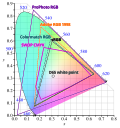CMYK color model
The CMYK color model is a subtractive color model, based on the CMY color model, used in color printing. CMYK refers to the four inks used in printing: cyan, magenta, yellow, and key (black).
The CMYK model is subtractive. It means that it subtracts or masks colors from white background of the paper. The ink reduces the reflected light. White light minus red leaves cyan, white light minus green leaves magenta, and white light minus blue leaves yellow.
White is the natural color of the paper, while black results from a full combination of colored inks. To save cost on ink, and to produce deeper black tones, unsaturated and dark colors are produced by using black ink instead of pure mix of cyan, magenta, and yellow.
Using black ink
The "black" produced by mixing usual cyan, magenta, and yellow inks is actually a dark grey color. So, modern four-color printing uses black ink in addition to the subtractive primary colors. Common reasons for using black ink include:[1]
- Text is typically printed in black and includes fine detail, difficult to reproduce with a mix of three inks.
- A combination of 100% cyan, magenta, and yellow inks soaks the paper with ink, making it slower to dry.
- Although a combination of 100% cyan, magenta, and yellow inks should, in theory, produce a perfect black, practical inks cannot do it and the result is actually a dark muddy color that does not quite appear black.
- Using black ink is less expensive than using the corresponding amounts of colored inks.
CMYK Color Model Media
Inspection CMYK colors of offset printing on a paper
Comparison of some RGB and CMYK color gamuts on a CIE 1931 xy chromaticity diagram
Spectrum of the visible wavelengths on printed paper (SCA Graphosilk). Shown is the transition from red to yellow. White, red, blue, and green are shown for reference. Readings from a white orchid flower, a rose (red and yellow petals), and a red cyclamen flower are shown for comparison. The units of spectral power are simply raw sensor values (with a linear response at specific wavelengths).
Related pages
References
- ↑ Roger Pring (2000). WWW.Color. Watson–Guptill. p. 178. ISBN 0-8230-5857-3.
Other websites
| Wikimedia Commons has media related to Lua error in Module:Commons_link at line 62: attempt to index field 'wikibase' (a nil value).. |
- XCmyk Archived 2011-12-30 at the Wayback Machine – CMYK to RGB Calculator with source code
- Color Space Fundamentals – animated illustration of RGB vs. CMYK








